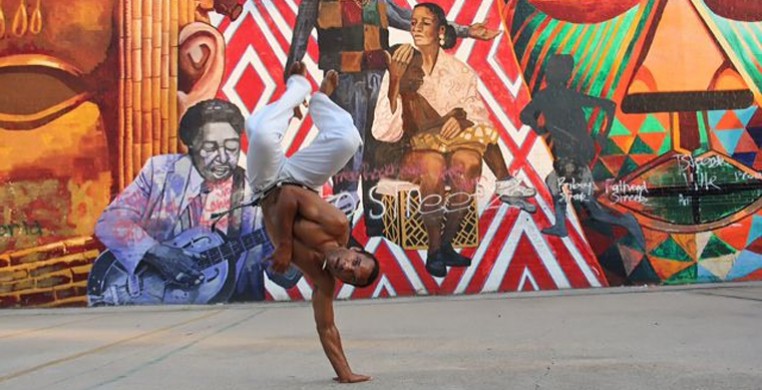The Dance Center of Columbia College’s first ever Afro-Latin@ Summer Dance Intensive wrapped up this past week with performances featuring the fusion of African, Latin, and contemporary concert dance forms. Choreographers from Puerto Rico, Cuba, Brazil, Mexico, and Venezuela joined Latin dance-based U.S. artists in four performances. A sampler of how these rich dance resources are infusing contemporary choreography began with a Bomba performance at Africaribe Cultural Center on Tuesday. Wednesday and Thursday offered two separate programs, dubbed “Post-Modern Latinidad,” at the Dance Center, and a Friday night club celebration at Latin Rhythms gave Summer Intensive students a chance to show what they had learned from the array of teacher/artists they had studied with over the course of the past two weeks.
Wednesday night’s program at The Dance Center opened on a happy note with Awilda Rodriguez Lora’s Mama Awilda: El Duet pt.1. Dressed in black tunic and tights, the choreographer began a relaxed, pedestrian entrance across the stage, intercepting a slow stream of men and women with smiles and warm hugs as they entered, in street clothes, from the opposite wings. Clearly pre-appointed audience members soon left their seats to join them on-stage for an informal “love-in” that congealed in a line-up across the front of the stage, a rainbow mix of size, shape, gender, and race, after which they filtered back into the audience, leaving Awilda alone on stage. She fetched a length of electronic cable and carried it unceremoniously to the opposite side, plugging the cable into a small television, and tenderly lifting the television into her arms. What followed this curious prelude was a “duet” with TV, the TV doubling variously as body part, alter-ego, and bed-time teddy bear. The performer embraced the television as if it were her inner child, popping a cassette into its mouth as if feeding it a delicious snack. Instantly, a projection of Awilda appeared simultaneously on both TV and across the upstage wall, reflecting Ms. Lora’s movement as she executed it in real time. On-stage movement and video projection soon diverged, as a tape of Awilda cutting “Mama’s” hair played on the big screen. Tender scenes of dialogue (in Spanish with subtitles) between the two revolve around marriage, men, childbearing, and being identified as “queer,” which “Mama” translates as “weird.” Mama’s message: “You have to appear strong.” But the content of their conversation seemed less important than the sheer love between the two women on the screen and Awilda’s simple but poignant gestural language on stage. She wiggles and arches her fingers, covers her mouth, tastes her fingers, extends a leg, and rests the TV on her belly, a birth perhaps.
Joel Valentin-Martinez’s duet, Wind, identified in the program as “a developing work,” was not ready for public performance in structure or execution. The most interesting element of the piece was the sound of distant voices calling and the sense of space that created. The combination of Gregorian chant and Latin music and the intriguing suggestion of renaissance-era clown costumes had little connection to the movement, a series of generic dance steps, that has yet to find its own voice and purpose.
In The River of Her Eyes, co-choreographed by Nerri Torres, with solo performer Onye Ozuzu, is a slight, lyrical interlude in which Ms. Ozuzu, in flowing white tunic and pants, sings in Spanish while her movement seemingly embraces a cherished memory. Contractions on the floor, arms undulating like wings, and a pantomime of applying make-up all take place against a watery abstraction, projected across the upstage wall.
Chicago choreographer Victor Alexander’s new work, Among Us, offered the most polished performances and substantial movement design of the evening. Dancers Maray Gutierrez, Jessie Gutierrez, Armando Marten, and Edson Cabrera brought an engaging sense of play to Alexander’s lush exploration of relationship through weight, balance, and rhythm. It was just plain fun to watch this excellent quartet of dancers discovering the fascinating ways they could connect and separate, lift and rebound from each other. Spoken repartee in Spanish peppered whimsical interaction between the couples. A modern dance idiom underscored this highly original study, whose strength was in the unusual partnering, both same gender and male-female, which culminated in a human knot.
The enthusiasm generated by this first Chicago festival of Afro-Latin forms bodes well for the future. In calling attention to the diversity of its broad-reaching styles and creative possibilities, Columbia College dance faculty member and Summer Intensive curator Raquel Monroe has brought welcome exposure to both dancers and Chicago audiences. Chicago can only be the richer for a sequel next year.

